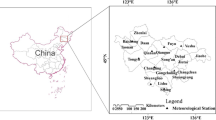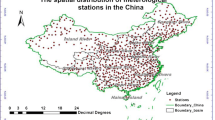Abstract
Global analyses show that climate change has already increased the frequency and strength of extreme weather events. The observed and remote-sensed precipitation productions have been deeply studied considering the stationary and non-stationary characteristics of extreme series. However, as these studies largely addressed the evolution of precipitation extremes at a single station, the consistency risk of extremes at multiple stations within close days has been little researched. In this paper, a multivariate frequency analysis method is proposed to reveal the exceeding and coincidence probabilities of the most dependent extreme precipitation series. First, a generalized extreme distribution, which has proved better at describing the tail behavior of extreme series, is developed to simulate the marginal distribution of rainfall extremes. Then, a mixed von Mises distribution is introduced to fit the occurrence time interval of the extreme events. Taking advantage of its flexibility in choosing arbitrary marginals, a copula is constructed to implement a joint probability analysis of extreme precipitation events at multiple stations. The upper reaches of the Yangtze River, where frequent heavy rains are the main source of the regional floods, were selected as a typical research area. Five hundred twenty-eight copula models were finally constructed by arbitrarily choosing two precipitation extreme series among the total 33 meteorological stations. The results revealed the risk of extreme rainfall occurrence once in 2, 5, 10, 20, 50, or 100 years, within a time interval of 1–90 days. The research has great significance for understanding complicated extreme events and is helpful for the disaster emergency response and management.






Similar content being viewed by others
References
Bing J, Deng P, Zhang X, Lv S, Marani M, Xiao Y (2018) Flood coincidence analysis of Poyang Lake and Yangtze River: risk and influencing factors. Stochastic Environmental Research & Risk Assessment 32(4):879–891
Chen L, Singh VP, Lu W, Zhang J, Zhou J, Guo S (2016) Streamflow forecast uncertainty evolution and its effect on real-time reservoir operation. J Hydrol 540:712–726
Coles S (2001) An introduction to statistical modeling of extreme values. Technometrics 44(4):397–397
Donat MG, Lowry AL, Alexander LV, O’Gorman PA, Maher N (2016) More extreme precipitation in the world’s dry and wet regions. Nat Clim Chang 6(5):508
Fan YR, Huang WW, Huang GH, Huang K, Li YP, Kong XM (2016) Bivariate hydrologic risk analysis based on a coupled entropy-copula method for the Xiangxi River in the Three Gorges Reservoir area, China. Theoretical & Applied Climatology 125 (1-2):381–397
Fisher NI (1993) Statistical Analysis of Circular Data. Cambridge University Press
Goswami UP, Bhargav K, Hazra B, Goyal MK (2018a) Spatiotemporal and joint probability behavior of temperature extremes over the Himalayan region under changing climate. Theoretical and Applied Climatology 134 (1-2):477–498
Goswami UP, Hazra B, Goyal MK (2018b) Copula-based probabilistic characterization of precipitation extremes over North Sikkim Himalaya. Atmospheric Research 212:273–284
Guan Y, Zheng F, Zhang X, Wang B (2017) Trends and variability of daily precipitation and extremes during 1960–2012 in the Yangtze River Basin, China. Int J Climatol 37(3):1282–1298
Guo E, Zhang J, Si H, Dong Z, Cao T, Lan W (2017) Temporal and spatial characteristics of extreme precipitation events in the Midwest of Jilin Province based on multifractal detrended fluctuation analysis method and copula functions. Theor Appl Climatol 130(1-2):597–607
Guo S, Chen L, Singh VP (2012) Flood coincidence risk analysis using multivariate copula functions. J Hydrol Eng 17(6):742–755
Huang K, Chen L, Zhou J, Zhang J, Singh VP (2018) Flood hydrograph coincidence analysis for mainstream and its tributaries. J Hydrol 565:341–353
Jakubowski W (2006) An application of the bivariate generalized Pareto distribution for the probabilities of low flow extremes estimation. Hydrol Earth Syst Sci Discuss 3(3):859–893
Joe H, Li H, Nikoloulopoulos AK (2010) Tail dependence functions and vine copulas. J Multivar Anal 101(1):252–270
Li J, Zhang Q, Chen YD, Singh VP (2015) Future joint probability behaviors of precipitation extremes across China: spatiotemporal patterns and implications for flood and drought hazards. Glob Planet Chang 124:107–122
Miao C, Ashouri H, Hsu KL, Sorooshian S, Duan Q (2015) Evaluation of the PERSIANN-CDR daily rainfall estimates in capturing the behavior of extreme precipitation events over China. J Hydrometeorol 16 (3):1387–1396
Nelsen B (2006) An introduction to copulas. Springer, New York
Otieno BS, Anderson-Cook CM (2006) Measures of preferred direction for environmental and ecological circular data. Environmental & Ecological Statistics 13(3):311–324
Pan Z, Zhang Y, Liu X, Gao Z (2016) Current and future precipitation extremes over Mississippi and Yangtze River basins as simulated in CMIP5 models. J Earth Sci 27(1):22–36
Pangaluru K, Velicogna I, Sutterley TC, Mohajerani Y, Ciracì E, Sompalli J, Rao SVB (2018) Estimating changes of temperatures and precipitation extremes in India using the Generalized Extreme Value (GEV) distribution. In: AGU Fall Meeting Abstracts
Rana A, Moradkhani H, Qin Y (2017) Understanding the joint behavior of temperature and precipitation for climate change impact studies. Theor Appl Climatol 129(1-2):321–339
Salvadori G, Michele CD (2010) Multivariate multiparameter extreme value models and return periods: a copula approach. Water Resour Res 46(10):219–233
Schwarz G (1978) Estimating dimensions of a model. Ann Stat (6)2
Sklar A (1973) Random variables, joint distribution functions, and copulas. Kybernetika 9(6):449–460
Steinschneider S, Lall U (2015) A hierarchical Bayesian regional model for nonstationary precipitation extremes in Northern California conditioned on tropical moisture exports. Water Resour Res 51(3):1472–1492
Thiombiano AN, El Adlouni S, St-Hilaire A, Ouarda TB, El-Jabi N (2017) Nonstationary frequency analysis of extreme daily precipitation amounts in Southeastern Canada using a peaks-over-threshold approach. Theor Appl Climatol 129(1):413–426. https://doi.org/10.1007/s00704-016-1789-7
Wi S, Valdés JB, Steinschneider S, Kim TW (2016a) Non-stationary frequency analysis of extreme precipitation in South Korea using peaks-over-threshold and annual maxima. Stochastic environmental research and risk assessment 30(2):583–606
Wi S, Valdés JB, Steinschneider S, Kim TW (2016b) Non-stationary frequency analysis of extreme precipitation in South Korea using peaks-over-threshold and annual maxima. Stochastic Environmental Research and Risk Assessment 30(2):583–606
Kvd Wiel, Kapnick SB, Oldenborgh GJv, Whan K, Philip S, Vecchi GA, Singh RK, Arrighi J, Cullen H (2017) Rapid attribution of the August 2016 flood-inducing extreme precipitation in south Louisiana to climate change. Hydrol Earth Syst Sci 21(2):897– 921
Xiao M, Zhang Q, Singh VP (2015) Influences of ENSO, NAO, IOD and PDO on seasonal precipitation regimes in the Yangtze River basin, China. Int J Climatol 35(12):3556–3567
Yan B, Chen L (2013) Coincidence probability of precipitation for the middle route of south-to-north water transfer project in China. J Hydrol 499(9):19–26
Zhang Y, Sun A, Sun H, Gui D, Xue J, Liao W, Yan D, Zhao N, Zeng X (2019) Error adjustment of TMPA satellite precipitation estimates and assessment of their hydrological utility in the middle and upper Yangtze River Basin, China. Atmospheric Research 216:52–64
Funding
This work is supported by the National Natural Science Foundation of China (51809242).
Author information
Authors and Affiliations
Corresponding author
Ethics declarations
Competing interests
The authors declare that they have no conflict of interest.
Additional information
Publisher’s note
Springer Nature remains neutral with regard to jurisdictional claims in published maps and institutional affiliations.
Data availability statement
The data used to support the findings of this study are available from the corresponding author upon request.
Rights and permissions
About this article
Cite this article
Zhu, S., Xu, Z., Luo, X. et al. Assessing coincidence probability for extreme precipitation events in the Jinsha River basin. Theor Appl Climatol 139, 825–835 (2020). https://doi.org/10.1007/s00704-019-03009-1
Received:
Accepted:
Published:
Issue Date:
DOI: https://doi.org/10.1007/s00704-019-03009-1




